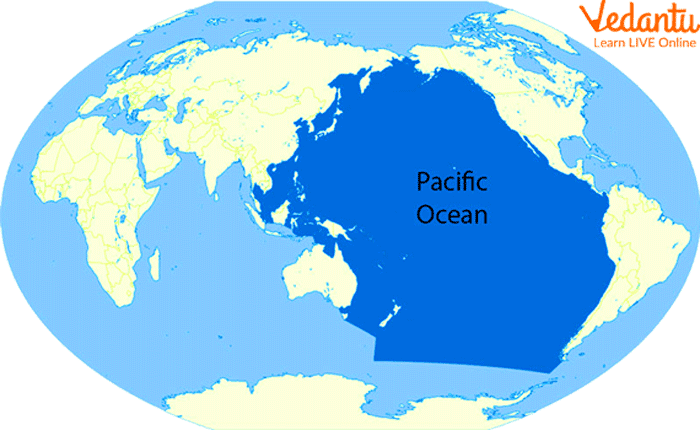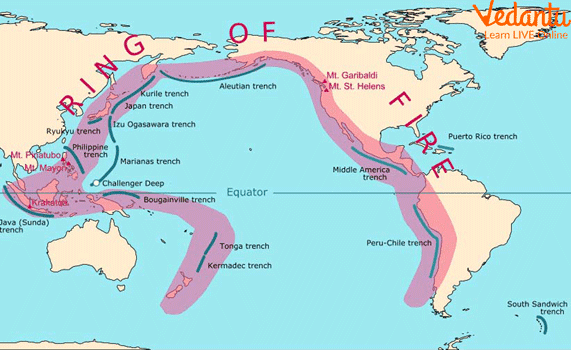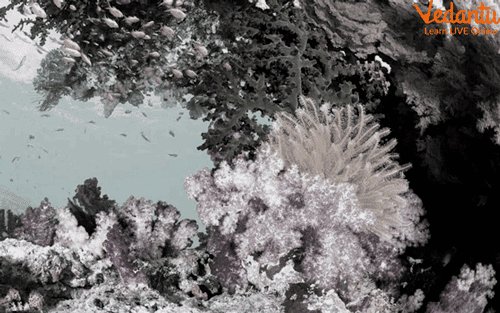




Why Study the Pacific Ocean in Class Live EVS?
The Pacific Ocean is the biggest ocean on Earth. More of the Earth's surface is covered by it than by all dry land combined. The ocean was given the name El Mar pacifico, or "the calm sea," by the adventurer Ferdinand Magellan. By far the largest, the Pacific region takes up nearly one-third of the earth's surface.
The most significant rivers that flow into the Pacific Ocean are those that originate in China and Southeast Asia. About 50.1% of the oceanic water on Earth is contained in the Pacific Ocean. From California to China, it covers 60 million square miles and, in some places, extends hundreds of feet below the water's surface.

Pacific Ocean
Features of the Pacific Ocean
The Mariana Trench, located close to the Mariana Islands, is the deepest spot in the Pacific or anywhere on Earth. It is substantially deeper than Mount Everest, the highest mountain on Earth, at 36,201 feet. The massive Pacific Plate is located under much of the Pacific Ocean. In relation to other plates, a plate is a stiff portion of the Earth's crust that moves slowly.
The Pacific Plate is surrounded by a number of these other plates. There are lots of volcanoes and earthquakes that occur when these plates collide. The term "ring of fire" refers to the sequence of volcanoes that encircles the Pacific.

Pacific Plate
The Shape of the Pacific Ocean
One-third of the earth's surface is covered by the nearly triangular Pacific Ocean, which has its northernmost point at the Bering Strait. Its 165.25 million square kilometres make up more surface area than all the land on Earth put together. Over half of all 25000 islands in the world are found in the Pacific, the majority of which are south of the equator. With two exceptions, the Galapagos and Gilbert Islands are considered to be entirely within the South Pacific despite crossing the equator. The Pacific Ocean is divided by the equator into the North Pacific Ocean and the South Pacific Ocean.
Animals in the Pacific Ocean
Marine ecosystems in the Pacific Ocean have a variety of interactions between animals and plants. Small animals of all kinds find homes in the plants of the Pacific Ocean, and predators depend on the ecosystems developed around these plants for the provision of prey. Some of the Pacific Ocean's most diverse organisms can be found in fish. Invertebrates in the Pacific Ocean play a significant role in the food chain.
Animals ranging from blue whales to elephant seals depend on crustaceans like krill, shrimp, and crabs for vital nutrients. Reptiles are probably not what you picture when you picture the water. However, the Pacific Ocean is home to six different species of sea turtles, including the flatback, green, Pacific ridley, hawksbill, loggerhead, and leatherback.
The western Pacific Ocean is home to numerous species of sea snakes in addition to sea turtles. The specially adapted marine iguana is the last species, and it braves the choppy waters off the Galapagos Islands to feed on algae. The Pacific Ocean is home to several different kinds of marine mammals. The largest group consists of cetaceans, which include whales and dolphins.

Flora and Fauna of the Pacific Ocean
The Economy of the Pacific Ocean
Mineral resources are rich in the Pacific Ocean. People consume magnesium, bromine, and salt from the water. From the seafloor, they remove phosphate rock, gravel, and sand. A wide diversity of fish and other marine life can be found in the ocean. Additionally, a lot of ships in the Pacific Ocean transport products between nations.
Conclusion
The largest known ocean on Earth is the Pacific Ocean. From California to China, it covers 60 million square miles and, in some places, extends hundreds of feet below the water's surface. The word "pacify" or "peaceful" appears in the name Pacific. The Pacific, despite its name, is a huge body of water alive with activity. Although there is still much of the ocean that has yet to be discovered, human activities like industrial fishing, deep-sea mining, and fossil fuel burning have already had a huge impact on it. The enormous expanse of water contains the deepest depths known to humanity and is home to some of the most unusual life types on Earth.
FAQs on Explore the Pacific Ocean: Shape, Features & Animals
1. What are the pacific ocean's environmental concerns?
Particularly close to the beaches of major towns and ports, people have polluted several areas of the Pacific. The ocean now contains significant volumes of industrial waste, sewage, fertilisers, and pesticides. Significant issues have arisen in coastal communities as a result of ship oil spills. Additionally, the abundance of some fish and other sea creatures has drastically decreased due to overfishing in the Pacific. Plastic makes up to 90% of the debris that may be seen floating in the Pacific Ocean.
2. What purpose does the Pacific Ocean serve?
The Pacific plays a significant role in the global economy, especially for the countries whose territory its seas immediately touch. It offers affordable maritime travel between the East and West, vast fishing grounds, offshore oil and gas reserves, minerals, and sand and gravel for the building sector. In 1996, the Pacific Ocean accounted for more than 60% of all fish caught globally. The U.S., Australia, New Zealand, China, and Peru are all relying more and more on the exploitation of offshore oil and gas deposits for their energy needs.









